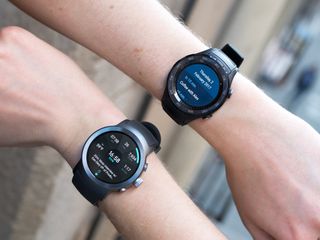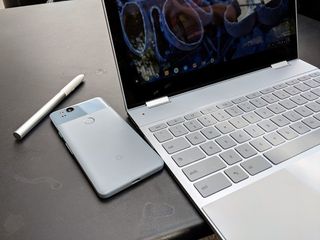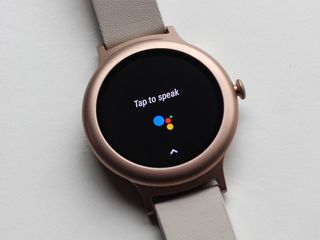Android Wear needs way more than just a Wear OS rebrand

Google first launched Android Wear in 2014, and since then, the platform hasn't changed all that much. Android Wear 2.0 introduced a slightly updated UI and a few new features in 2017, and on March 15, 2018, Google announced that it was re-branding Android Wear as "Wear OS by Google."
The purpose of the new name and logo is to shine some light on Android Wear being open to Android and iOS users alike, and it follows in Google's recent pattern of axing the Android name from its other products and services (RIP Android Pay). The name is catchy and the logo looks good, but Google's going to need to a lot more if it wants Android Wear/Wear OS to succeed and put a dent in recent activity from Apple, Fitbit, and Samsung.
Completely overhaul Google Fit
Fitness has become a massive focus for smartwatches, so much so that Apple markets the health-focused features of the Apple Watch almost more than anything else. Even after wearing an AW myself for just a few short months, I almost instantly became addicted to closing those blue, yellow, and red rings.
Unfortunately, Wear OS doesn't currently have anything that can compete with Apple, Fitbit, or even Samsung for that matter.

Google Fit is the out-of-the-box fitness suite that comes with every Wear OS device, but it's pretty clear that Google's all but taken it behind a shed to be shot. There's no way to log your food intake, water consumption, or sleep. You can't create fitness challenges between you and other users, there aren't any badges/trophies to collect for your hard work, and the companion app offers very little insight into previous workouts.
A health/fitness platform that's designed by Google and links right to your Google account should be an easy sell, but in its current form, Google Fit pales in comparison to Fitbit, Apple Health, and Samsung Health.
Fitness/health tracking is becoming a bigger and bigger reason people buy smartwatches with every passing day, and with Google Fit in its current form, it's an immediate turn-off from Wear OS for anyone that's serious about trying to live a healthier life.
Be an expert in 5 minutes
Get the latest news from Android Central, your trusted companion in the world of Android
Seriously, where is the Pixel Watch?
Plenty of people before me have pleaded with Google to create a Pixel Watch, but that's not going to stop me from doing so for the 1839th time.

Before Google launched the Pixel line, Nexus phones were seen as nothing more than devices that Android die-hards geeked out over because of their top-of-the-line specs and new software goodies with the latest version of Android. The Pixel and Pixel 2 offer a lot of what made the Nexus line so great, but now they're being sold on carriers, Google's marketing them to general consumers, and people are now choosing between Pixel and Galaxy phones when it's time to upgrade.
The Pixel brand is starting to mean something, and that's important.
Google is one of the most well-known companies on the planet, and that's why you see its logo on the Pixel 2's box, the back of the phone, and on the home screen. It's teaching people that "Pixel" is synonymous with "Google", and now that that brand awareness is starting to form, people will easily pick up on the fact that a Pixel Watch is made by Google and will pair nicely with their Pixel 2,3, or whatever.
I'll get into what I'd like to see from the hardware in just a second, but Google's main battle lies in marketing and branding. Consumers know that the Apple Watch perfectly compliments the iPhone and that Fitbit wearables are meant for people who want to be healthier. When it (inevitably) releases the Pixel Watch, Google needs to lay out an extensive promotional campaign and ensure people know exactly why they should buy it over an Apple Watch, Fitbit Versa, or Samsung Gear Sport.
Pixel Watch Pt. 2
Alright, so Google's got its work cut out for itself when it comes to branding the Pixel Watch, but what kind of hardware will appeal and connect with buyers?
There are plenty of third-party OEMs still making Wear OS watches, but the vast majority of companies keeping it alive are fashion brands like Skagen, Fossil, and Kate Spade.
Similar to the Pixel phones and Pixelbook, the Pixel Watch should have a simple yet attractive design that looks good on both male and female wrist. I know I've already made a lot of compassion to the Apple Watch, but this is something it excels at.
A heart-rate sensor needs to be on board, as does NFC for mobile payments and a built-in GPS for easily mapping your runs without having to carry your phone. If Google wants to have a watch with LTE connectivity, do what Apple does and have a separate model specifically for that.
As for pricing, I think something around $250 or $299 would be the sweet spot.
Will any of this happen?

Alongside the Wear OS announcement, Google did say that one of its main focus points for future software updates lies with new fitness features. In addition to this, a Google Fit companion app is finally coming to iOS in the coming weeks. We still aren't sure what kind of new fitness features Google's working on, but it's encouraging nonetheless to see it investing time and money into Google Fit.
Google's in a great position to do something meaningful with Wear OS.
Will we see a Pixel Watch this year? I'd bet that we do. I'm guessing Google will take more about new software updates/features for Wear OS at I/O this May, and we'll get a hardware announcement later in the year with the Pixel 3.
The timing would be perfect to go along with Android Wear's name change, and I can't imagine Google would pass up on an opportunity like this to really make something out of Wear OS.
Now that my rambling is done, I'd like to hear from you. What do you think Google needs to work on in order to make Wear OS a success? Sound off in the comments below!
Joe Maring was a Senior Editor for Android Central between 2017 and 2021. You can reach him on Twitter at @JoeMaring1.

